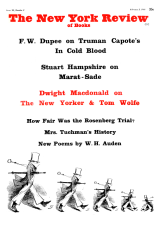In response to:
Blake and the Scholars: I from the October 28, 1965 issue
To the Editors:
Professor Antony Blunt is a deservedly respected art historian, but his review of the recent books on Blake by Professors E. D. Hirsch and Jean Hagstrum seems to me neither quite accurate nor quite fair. On a minor point, he credits Ellis, in the “early years” of this century, with having invented Blake’s mythical Irish ancestor, when credit should go to Yeats, in the edition of Blake which he prepared with Ellis in 1893. He accuses Mr. Hirsch of contradicting his own interpretation of “Infant Joy” by printing the poem with inverted commas when he believes it to have only one speaker, when it is quite clear from Mr. Hirsch’s text that he is at that point quoting the poem as it had appeared in Wicksteed’s text (or in the early Keynes), for the purpose of criticizing Wicksteed’s interpretation. He also writes that “Mr. Hirsch treats ‘Infant Joy’ as illustrating the cycle of man’s life from Innocence through Experience to the final return to Innocence,” when a major thesis of Mr. Hirsch’s book is that when composing Songs of Innocence Blake had not yet conceived of the state of Experience. He then goes on to criticize Mr. Hagstrum’s finding Freudian phalluses in the illumination for the poem, when of course Mr. Hagstrum is merely alluding to an interpretation that has been common enough in Blake criticism since first proposed by Wickteed in 1928, a critic whom Mr. Blunt justly praises earlier in the review (to closed flowers in this poem as representing open and closed wombs; in the companion poem, “The Blossom,” he sees the vegetation as representing “phalluses, prone and erect”).
If looking for sources for Blake’s visual art is an “all-too familiar parlor game,” it is one Mr. Blunt was himself indulging in five or six years ago. Finally, Mr. Hagstrum’s book is the first full-scale attempt to interpret Blake’s own works as integral units of poetry and painting (Mr. Blunt’s own somewhat desultory collection of essays makes no such attempt), and that by a recognized authority on these “sister arts” in the eighteenth century: his book should be reviewed for what it is, and not condescendingly dismissed as a “sensible summary.”
Peter L. Thorslev, Jr.
Department of English
University of California
Los Angeles
Antony Blunt replies:
I am sorry that Mr. Thorslev should find my review unfair, but with all respect I do not feel his charges are of very great weight.
Strictly speaking I may have been inaccurate in using the word Experience in connection with Mr. Hirsch’s interpretation of Infant Joy, but I do not think the distortion of his meaning was gross. What he writes in his notes to the poem is: “The cycle of life as conceived in the poems of Innocence is a departure from Eternity, into a period of mixed joy and sorrow on Earth where man re-enacts the Christ story in order to learn ‘Love’ and ‘Understanding,’ before he returns to Eternity.” As regards the use of inverted commas, if Mr. Hirsch’s intention was what Mr. Thorslev attributes to him—which is not so clear to me as to Mr. Thorslev—I think he would have done well to indicate the fact in a footnote.
If I was inaccurate in saying that Ellis and Mr. Hagstrum were the first to propose certain ideas, this does not affect my estimate of those ideas. Because they are older, they are not necessarily better.
As for the parlor game, of course I played it; indeed I rather thought I had invented it—but twenty years and more ago, not “four or five.” But once again it is not the better for being older; on the contrary, I believe it was worth while showing that the game could be played, but I do not think it is worth while to go on playing it unless one can produce new types of result, not merely new specimens.
This Issue
February 3, 1966



